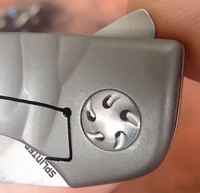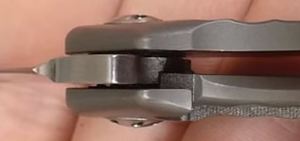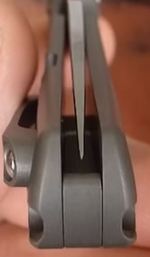We independently evaluate all recommended products and services. Any products or services put forward appear in no particular order. If you click on links we provide, we may receive compensation.
You may not know much about Chinese knife maker, Kizer and the mere sight of the “Made in China” stamp will send many of you running to the hills. Still, if you hear me out you may be surprised to learn that Kizer is producing some interesting blades, including the one I’m reviewing here in the Kizer Splinter, model Ki3457.

The fact of the matter is that barriers continue to fall in the international marketplace and the rise of China as an economic powerhouse is leading to some interesting options for the consumer. In the knife community, the entrance of companies like Kizer and Reate, is not going unnoticed.
Key Specs: Kizer Splinter
Overview
Kizer Cutlery certainly had some growing pains, with designs that skirted outright copies and accusations of misrepresenting their materials. Let me tell you, put all of those fears to rest, because Kizer has been exhaustively investigated by a legion of knife community sleuths, and as it turns out they are making genuinely great tools with top notch materials, and collaborating with some of the most popular knife designers from around the world.
One of those design collaborations has been with TomCat knives (designer Tom Stokes), who has partnered with Kizer to release a series of folding tactical knives. Their latest offering is the Kizer Splinter, a fantastically slim and sexy EDC knife that looks great in a pair of slacks or a pair of jeans, that is chock full of all the latest and greatest innovations knife making has to offer.
The Blade
The blade of the Kizer Splinter is such an interesting and eye-catching shape, somewhere between a modified drop point and a wharncliffe blade shape. It offers a long, nearly straight edge with a gentle hollow grind that gives you an insane cutting edge without sacrificing the ability to make piercing cuts.
 Near the tip of the blade there is a swedge on the spine, this enhances the piercing ability that the blade shape offers and definitely makes for an eye-pleasing departure from the norm. The blade has been polished and stonewashed, so it excels at hiding scratches from use, while still making a handsome looker for those who prefer classy blades.
Near the tip of the blade there is a swedge on the spine, this enhances the piercing ability that the blade shape offers and definitely makes for an eye-pleasing departure from the norm. The blade has been polished and stonewashed, so it excels at hiding scratches from use, while still making a handsome looker for those who prefer classy blades.
The presentation side of the blade sports Kizer’s new logo, which is much more tasteful than their initial stamp, as well as the steel designation at the base and model number on the flipper tab. On the lock side you will find TomCat’s logo, and while I appreciate that they want to get their name on a knife this well made, it can make the blade look a bit like a billboard.
In terms of steel, Kizer used Crucible’s premium CPM alloy in S35VN, an awesome next-gen material that takes a super keen edge and holds it a long time, with fantastic marks in both toughness and stain resistance. CPM-S35VN is seemingly everywhere in the high end knife market lately, and for good reason: the steel is easy for makers to work with, it’s readily available, and it scores high marks across the board in all measured categories. Consider it a slightly enhanced version of our beloved S30V.

The blade length on the Kizer Splinter is right at the sweet spot for me, over 3 inches but less than 3.5. I find that this is the length needed for just about all EDC tasks you’ll encounter day to day. If you’re like me and you sharpen your own knives, or even if you only just strop your knives for upkeep, the straight edge that the Splinter offers makes sharpening and stropping super easy. The slender outline of the blade even resembles the knife’s namesake, it’s like a super steel splinter!
Handle and Ergonomics
 Titanium handle scales can get a bit boring, let’s be honest, because they are generally bland in color and shape. Well, I challenge you to find a titanium handle quite as unboring as the Kizer Splinter. They are offered in both stonewashed and anodized versions, and are extensively milled in an almost Cuscadi pattern (basically staggered opposing milled sections) which adds to the attractive look as well as making the grip even more excellent.
Titanium handle scales can get a bit boring, let’s be honest, because they are generally bland in color and shape. Well, I challenge you to find a titanium handle quite as unboring as the Kizer Splinter. They are offered in both stonewashed and anodized versions, and are extensively milled in an almost Cuscadi pattern (basically staggered opposing milled sections) which adds to the attractive look as well as making the grip even more excellent.
The finger choil is deep and locks your hand into the handle, which is a good thing because the handle, like the blade, is super slim and fairly skinny. If you are a fan of beefy handles that fill your palm completely, you may want to look elsewhere, but for a knife to slide easily into your pocket and hand, this thing is great.
The handle tapers just slightly down from the finger choil to the end, but I never felt like it was so skinny or slim that I couldn’t grip it well enough for any task, and there was room for a full grip (I have medium-large hands).
I opted for the anodized version, and Kizer didn’t disappoint when it comes to the artsy stuff: the base color of the handle is a light bluish gray, with a yellow and red smoky pattern running down the middle, almost looking like flame against a blue background. Sexy stuff folks.
The plain stonewashed version is a darker gray, and while it may not win any beauty pageants, it is very good at resisting marks and scuffs from use. One demerit I have to mention when it comes to the handle, there is a fairly sharp edge on the lock side of the knife where the lockbar is cut out, and it can catch your index finger in certain situations. It isn’t severe enough to cut you or anything, but it can certainly annoy you.
Deployment & Lockup
 With every new flipper I test I’m typically looking for how slick the action is. The Kizer Splinter delivers in spades when it comes to flipping action, with smooth and crisp deployment that will make you want to do it over and over. Right out of the box, a lot of flippers will be stiff and take time to break in properly, and that’s fine, but I like a knife that wows me immediately. This was one of those knives that flew out fast and furious from the first flip and just blew me away.
With every new flipper I test I’m typically looking for how slick the action is. The Kizer Splinter delivers in spades when it comes to flipping action, with smooth and crisp deployment that will make you want to do it over and over. Right out of the box, a lot of flippers will be stiff and take time to break in properly, and that’s fine, but I like a knife that wows me immediately. This was one of those knives that flew out fast and furious from the first flip and just blew me away.
One thing I hate to see is oversized and misplaced flipper tabs. Again, the Splinter breaks from the pack here with a very understated flipper tab that is placed right in line with the pivot, not below it. The tab could certainly use a bit of texturing or jimping, especially because of how small it is, but once you figure out how it works, you’ll realize how much better this design is than the older style.
 As an added bonus, the lower profile flipper also makes this a much skinnier knife in your pocket. One compromise of those who prefer svelte knives is settling for a weak or wobbly lockup. So, when I find a knife that packs a ton of blade into a small and skinny package, without sacrificing a secure lockup, I get excited, and let me tell you I’m excited about the Kizer Splinter.
As an added bonus, the lower profile flipper also makes this a much skinnier knife in your pocket. One compromise of those who prefer svelte knives is settling for a weak or wobbly lockup. So, when I find a knife that packs a ton of blade into a small and skinny package, without sacrificing a secure lockup, I get excited, and let me tell you I’m excited about the Kizer Splinter.
There is no steel insert in the lockbar, so you do have titanium mating with hardened steel, but the lockup is perfect, and there is no stick when you disengage the frame lock.
Features, Fit & Finish
The Splinter doesn’t skimp on features, like the ceramic detent ball and ceramic bearing washers, the 3-D machined titanium pocket clip that can be switched for left-handed carry (if you’re a lefty, you know how rare that is), and the amazing blade to handle ratio that crushes most competition.
 This knife is so packed with features in such a pocket friendly package it’s kind of hard to believe it costs as little as it does. Well, features are all well and good, but China is notorious for horrid fit and finish, right? Not anymore, folks. Kizer has fit and finish that is second to none, with perfect centering, absolutely amazing action without sacrificing blade stability, and zero flaws when it comes to blade grind, handle contouring, and milling.
This knife is so packed with features in such a pocket friendly package it’s kind of hard to believe it costs as little as it does. Well, features are all well and good, but China is notorious for horrid fit and finish, right? Not anymore, folks. Kizer has fit and finish that is second to none, with perfect centering, absolutely amazing action without sacrificing blade stability, and zero flaws when it comes to blade grind, handle contouring, and milling.
Bored of that hum-drum hardware most knives in this price range come with? The Splinter has customized hardware that adds yet another splash of class and style, along with a partial sandwiched titanium backspacer. The partial backspacer is a nice compromise between the full flow through design, which offers ease of cleaning, and the full backspacer, which offers added stability. I can honestly tell you, at this price range you’re going to be hard pressed to find anything that comes close to this knife in terms of features.
Field Test
When you’re in the market for a gentleman’s folder like this, chances are you won’t be using it for anything too rough, and I based my field testing around that idea. The field testing for this knife consisted of kitchen tasks, package and cardboard processing, and finally paracord cutting. In the kitchen I was happy to put the slim CPM-S35VN Splinter to work taking down apples, onions, cucumber, and even stuff as extreme as making a sandwich.
 The hollow grind on this blade leaves it with a very thin edge, and thin edges means slicing performance. Feel free to try my go to kitchen competition test, slicing a nearly paper thin piece of tomato without having the tomato squish at all, a test which the Splinter passed.
The hollow grind on this blade leaves it with a very thin edge, and thin edges means slicing performance. Feel free to try my go to kitchen competition test, slicing a nearly paper thin piece of tomato without having the tomato squish at all, a test which the Splinter passed.
Packaging and cardboard cutting went equally well, although in the time I was carrying it I only opened 5 or 6 boxes and then cut them down to pieces. It felt really nice being able to get through the cardboard without the blade catching at all, which can happen with some thicker stocks.
Paracord cutting is done in a variety of configurations for this test, first I check to see that my knife is sharp enough to cut phone book paper easily, then I make 20 cuts of 550 paracord and check again. The Kizer Splinter was still cutting phone book paper after 10 rounds, and after that I gave up (sorry, I get bored easily). No whacking through wood this time, but you wouldn’t be using this knife for that purpose.
Alternatives
All these knives available at BladeHQ.
What a tough category to tackle for this knife. Like I mentioned earlier, a knife with the kind of materials and craftsmanship that the Splinter is made with generally costs hundreds of dollars. So for an alternative I decided to stick to just the basics: it had to be a flipper with good action, it had to be slim and skinny, and it had to have a cool factor. Really, just one knife jumps to mind when I think of something like that, and it just so happens to be one of my “Best Budget Knives Under $50“. I’m talking about the CRKT Ripple.
If you find yourself unable or unwilling to spend the $120 that the Kizer Splinter will cost you, the Ripple is a great place to start. It has pretty darn good flipping action, runs on bearings, is super-duper skinny and pocket friendly, and it gets tons of style points for its alien looking design. I can’t say that it quite rivals the Splinter, but the Ripple does an admirable job anyway, and at less than half the cost so give it a look.
Wrap-Up
 Even after all I’ve said here today, I know there are guys and gals out there reading this who will see a knife made in China and dismiss it. Let me just say this, I get it. Supporting local knife makers is vitally important, for a multitude of reasons, and I am a big fan of buying American made knives (if you don’t believe me, ask my preferred knife dealers).
Even after all I’ve said here today, I know there are guys and gals out there reading this who will see a knife made in China and dismiss it. Let me just say this, I get it. Supporting local knife makers is vitally important, for a multitude of reasons, and I am a big fan of buying American made knives (if you don’t believe me, ask my preferred knife dealers).
But don’t let the stigma of past mistakes blind you to some pretty amazing changes coming out of this new crop of Chinese knife makers: they are using top of the line materials, they are collaborating with amazing designers from all over the world, and they are offering their products to the customer at an insanely competitive price.
You can still be a supporter of local knife makers, while supporting a growing trend of Chinese companies who no longer just make rip-off gas station junk, but really high quality tools. I want you to have your cake, eat your cake, and cut your cake with the Kizer Splinter!
- Excellent fit/finish, top line materials, swift deployment, feature packed
- One too many logos/stamps on the blade, not US made
Kizer Splinter
Quality/Performance - 78%
Value for Money - 81%
80%
Kizer silences the doubters with a beautifully made folder that doesn't cost the Earth





